Intel's Core i7 970 Reviewed, (Slightly) More Affordable 6-core
by Anand Lal Shimpi on July 29, 2010 3:23 AM ESTSYSMark 2007 Performance
Our journey starts with SYSMark 2007, the only all-encompassing performance suite in our review today. The idea here is simple: one benchmark to indicate the overall performance of your machine.
SYSMark is an example of what a mostly dual-core workload looks like. The 6-core advantage is nil, although the very large L3 cache makes up for it. In this case the Core i7 970 is just slightly slower than the quad-core 975.
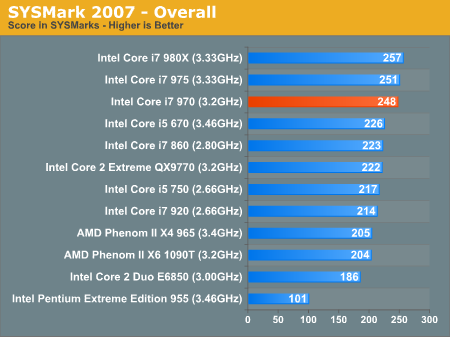
Adobe Photoshop CS4 Performance
To measure performance under Photoshop CS4 we turn to the Retouch Artists’ Speed Test. The test does basic photo editing; there are a couple of color space conversions, many layer creations, color curve adjustment, image and canvas size adjustment, unsharp mask, and finally a gaussian blur performed on the entire image.
The whole process is timed and thanks to the use of Intel's X25-M SSD as our test bed hard drive, performance is far more predictable than back when we used to test on mechanical disks.
Time is reported in seconds and the lower numbers mean better performance. The test is multithreaded and can hit all four cores in a quad-core machine.
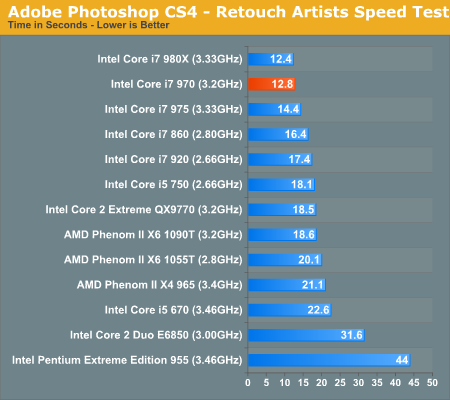
We loved the 980X for Photoshop use when it launched, and the 970 is no different. Photoshop can use the extra cores, although the performance difference isn't huge it's there.
DivX 6.8.5 with Xmpeg 5.0.3
Our DivX test is the same DivX / XMpeg 5.03 test we've run for the past few years now, the 1080p source file is encoded using the unconstrained DivX profile, quality/performance is set balanced at 5 and enhanced multithreading is enabled.
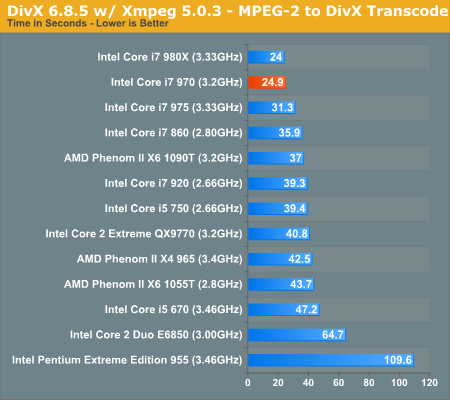
Video encoding is where it's at with the 6-core Gulftown processors. The 970 is hot on the heels of the 980X.
x264 HD Video Encoding Performance
Graysky's x264 HD test uses x264 to encode a 4Mbps 720p MPEG-2 source. The focus here is on quality rather than speed, thus the benchmark uses a 2-pass encode and reports the average frame rate in each pass.
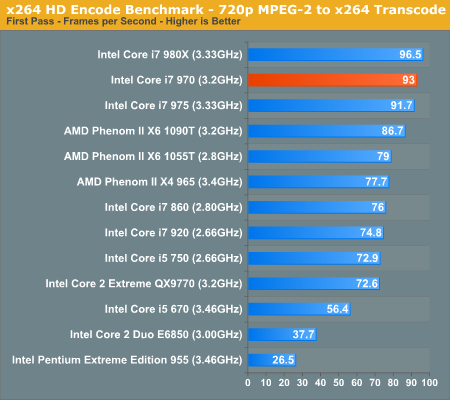
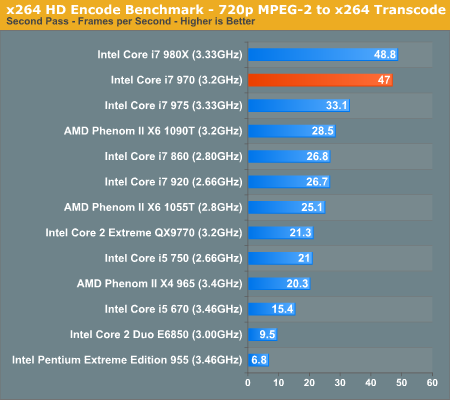
There's no replacement for core count in these heavily threaded workloads. The 970 is over 40% faster than the Core i7 975 and gives you 96% of the performance of a Core i7 980X.










49 Comments
View All Comments
afkrotch - Thursday, July 29, 2010 - link
Both of which would suck huge donkey nuts, if you plan on using it at home. Unless you just happen to be rendering complex scenes. Which most aren't. You'll benefit more from the 980X or 970, for quick simple renderings, modeling, etc. Course, I'm going to assume that many ppl who buy these procs just want the best on the market and couldn't care less how it actually performs.mavizao2 - Thursday, July 29, 2010 - link
Well,For barely $950, you can get an Asus mobo with 2 CPU slots and 2 8-way magnycours 2.0ghz.
That is...you can get 16 real cores, totalling 32 ghz AND the motherboard.
Do you really think Intel can get even CLOSE to the performance yelded?
Anything that uses more then 4 cores will probably use as many as it finds (encoding, crunching etc etc).
So, guess what...no freaking way.
Intel is only a better buy if you're some kind of rich gamer...even then, i suppose a regular core I7 overclocked will do better than a 6 core that can't overclock "as good", as the trend seems to be coding is stuck on using at most 4 cores.
Accord99 - Friday, July 30, 2010 - link
Actually yes, even in highly multi-threaded situations the i7-970 will be comparable to 2x6128s. And for the plenty of things that can't use 16 threads effectively, then it won't even be close.bleucharm28 - Thursday, July 29, 2010 - link
if i'm going to spend that much, i rather spend the extra $100 and buy 980X.tno - Thursday, July 29, 2010 - link
I think that's the point though. It's like Anand said, this is possibly an issue of binning. And before the haters keep on hating, let's consider what the sales numbers for these things are? EE's have never been sales leaders, they exist to show what will trickle down. Intel is so far head in their 32-nm node that they were able to get this thing out ahead of schedule and are probably working very hard to ramp up production at this node so that they can produce chips of this caliber at lower price points. I have the fullest expectation that within six months a nearly equivalent chip (minus AES and such a large L3) will be selling at the $400 price.What I want are features. I want Sandy Bridge to be a media and IO powerhouse, that can share graphics duties with a discrete GPU for huge power savings in the desktop realm. I want to be able to hear my freaking loud 4890 power all the way down when I'm watching a movie and then ramp up when I get my WoW on. I want 8 cores that will power down when not in use. I want IO integrated so that I don't have to slap a loud tiny fan over a Northbridge. And I want to build the whole system for less than $500 (plus that same 4890! ;) it does all I wanted). What do you think Anand? How far out am I from seeing my dream?
Etern205 - Thursday, July 29, 2010 - link
HD4890?Have you been living under a rock?
It's HD5800 for you buddy.
Etern205 - Thursday, July 29, 2010 - link
When I've read the title of a more affordable 6 cores, I was like yay!!!Then when I saw the price...
man this is like uber gay!
boden - Thursday, July 29, 2010 - link
*with lisp* this is like SUPER HAPPY!!!!!! like wow, spaztastic, rad.../sarcasm
CptTripps - Thursday, July 29, 2010 - link
I have been running the i7 920 since late late 2008, I am extremely happy that it still holds up so well and I see no reason to upgrade for at least another couple years.QChronoD - Thursday, July 29, 2010 - link
Totally agree. The only benchmark on here that I care about is the x264 encoding one. But my OC's 920@3.6 looks to be only a few percent slower than the new 970.Personally I'd like to see a 1080p benchmark, but thats not a big deal.
I do wish that you would add a highly overclocked chip to these benchmarks, like an old 920 @4.0 or something, so that us early adopters would be able to get an idea of how we still hold up to Intel's new hotness.